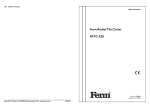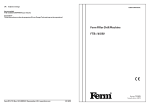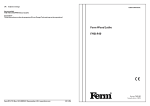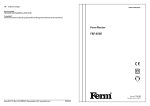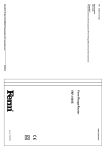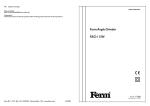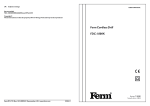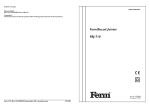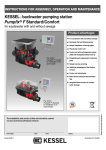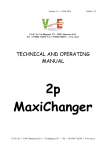Download Ferm Tile Cutter FTC-600
Transcript
UK Subject to change USER’S MANUAL Ferm Tile Cutter FTC-600 Art.nr. 720920 Ferm BV • P.O. Box 134 • 8280 AC Genemuiden • NL • www.ferm.com 0310-15 EXPLODED VIEW 5 6 7 8 1 2 3 9 10 11 4 Fig. 1 Fig. 2 Fig. 3 Fig. 4 2 Ferm Ferm 7 up place, out of reach of children. SPARE PARTS LIST FERM NR. 700600 700601 700602 407555 407456 700603 407558 407479 700604 700605 700606 407436 700607 407451 700608 DESCRIPTION MOTOR TABLE AXES + BOLT BLADE GUARD WITH SIDE GUIDE SCREW FOR TABLE PARALLEL GUIDE RIVING KNIFE OUTSIDE FLANGE NUT M12 FRONT PLATE INNER FLANGE WATERPROOF RING WATER CONTAINER SWITCH SCALE ON PARALLEL GUIDE Do not force the tool It will do the the job better and safer at rate for which it was intended. REF.NR 002 006 008+010+011 009 012 015 017 019 020 024 026 027 032 034 + 035 __ FERM TILE CUTTING MACHINE THE NUMBERS IN THE FOLLOWING TEXT CORRESPOND WITH THE PICTURES AT PAGE 2 TECHNICAL SPECIFICATIONS Voltage Frequency Power input No load speed Cutting angle Cutting capacity 90° Cutting capacity 45° Machine weight Lpa (sound pressure level) Lwa (sound power level) | | | | | | | | | | 230V 50Hz 600W 2950/min 0-45° 32mm. 22mm. 14kg. 53,6 dB(A) 66,6 dB(A) SAFETY INSTRUCTIONS The following pictograms are used in these instructions for use: Denotes risk of personal injury, loss of life or damage to the tool in case of non-observance of the instructions in this manual. Denotes risk of electric shock. GENERAL SAFETY INSTRUCTIONS Warning! When using electric tools basic safety precautions should always be followed to reduce the risk of fire, electric shock and personal injury. Read all these instructions before attempting to operate your product. Save these instructions for future reference. Keep work area clear Cluttered areas and benches invite injuries. Consider work area environment Do not expose tools to rain. Do not use tools in damp or wet locations. Keep work area well lit. Do not use tools in the presence of flammable liquids or gases. Guard against electric shock Avoid body contact with earthed or grounded surfaces. 6 Ferm Use the right tool Do not force small tools to do the job of a heavy tool. Do not use tools for purposes not intended; for example do not use circular saws to cut tree limbs or logs. Dress properly Do not wear loose clothing or jewellery, they can be caught in moving parts. Non-skid footwear is recommended when working outdoors. Wear protective hair covering to contain long hair. Use protective equipment Use safety glasses. Use face or dust macsk if cutting operations create dust. Connect to dust extraction equipment If devices are provided for the connection of dust extraction and collecting equipment, ensure these are connected and properly used. Do not abuse cable Never pull the cable to diconnect it from the socket. Keep the cord away from heat, oil and sharp edge. Secure Work Where possible use clamps or a vice to hold work. It is safer than using your hand. Do not over-reach Keep a proper footing and balance at all times. Maintain tools with care Keep cutting tools sharp and clean for better and safer performance. Follow instructions for lubricating and changing accessories. Inspect tool cords periodically and if damaged have them repaired by an authorized service facility. Inspect extension cords periodically and replace if damaged. Keep handles dry, clean and free from oil and grease. Disconnect tools When not in use, before servicing and when changing accessories such as blades, bits and cutters disconnect tools from the power supply. Remove adjusting keys and wrenches Form the habit of checking to see that keys and adjusting wrenches are removed from the tool before turning it on. Avoid unintentional starting Ensure that the switch is in off position when plugging in. Keep other people away Do not let others, especially children, not involved in the work touch the tool or the extension lead and keep them away from the work area. Use outdoor extension leads When the tool is used outdoors, only use an extension cable intended for outdoor use and so marked. Store idle tools When not in use, tools should be stored in a dry locked- Stay alert Watch what you are doing, use common sense and do Ferm 3 Secure the nut with a spanner gripping the flats on the end of the shaft with a second spanner. not operate the tool when you are tired. Check damaged parts Before further use of the tool, it should be carefully checked to determine that it will operate properly and perform its intended function. Check the alignment of moving parts, binding of moving parts, breakage of parts, mounting and any other conditions that may affect its operation. A guard or other part that is damaged should be properly repaired or replaced by an authorized service centre unless otherwise indicated in this instruction manual. Do not use the tool if the switch does not turn it on and off. Warning! The use of any accessory or attachment other than one recommended in this instruction manual may present a risk of personal injury. 4. Fit the riving knife (6, fig 1) using the 2 star headed screws at the rear of the blade. Take care to align this correctly with the blade and leave 3mm gap between the blade and the knife. 5. Refit the lower blade guard (24, Fig. 2). 6. Fit the top blade guard (5, fig 1) to the riving knife, using the nut and bolt supplied. Make sure that you do not over tighten as the guard must be free to pivot around this bolt. • Have your tool repaired by a qualified person This electric tool complies with the relevant safety rules. Repairs should be carried out by a qualified person using original pats, otherwise this may result in considerable danger to the user. SAFETY PROVISIONS • Before starting work, check your machine for damage, with particular reference here to the diamond blade. All parts must be fitted in the correct manner and must comply with all preconditions to guarantee optimum operation of the machine. For continued use of the machine, the safety facilities or slightly damaged parts should be tested for their correct operation. This must be carried out in accordance with the aforementioned preconditions. Moving parts, with particular reference to the protective cover for the diamond blade, should be securely fastened and may not stick or jam. Do not use machines which do not have a switch for starting up and shutting down. • The protective cover for the diamond blade may not be clamped in place or removed. A protective cover that sticks or jams should be repaired immediately. The riving knife may not be removed. SETTING UP THE TILE CUTTING MACHINE • For your own safety, only use accessories and auxiliary equipment which are mentioned in the instruction manual or have been recommended or mentioned by the manufacturer of the machine. Using other accessories or auxiliary equipment can carry the risk of causing injury to you or others. 1. Remove the lower blade guard (24, Fig. 2) on the underside of the machine (2 screws at the front and 2 at the back of the underside of the guard need removing) . (21,22 and 23, Fig. 2). Fig.1 • • • • • • 2. Remove blade nut (20, Fig. 2) and outer flange (19, Fig. 2) from the motor shaft. 3. Fit the blade and replace the outer flange and nut in accordance with figure 4. 4 CUTTING GUIDE Fig.1 It is possible to cut parallel to another guiding edge using the cutting guide (7). Adjustment: undo the knobs (9) and adjust to the desired distance. Retighten the knobs. The markings on the ruler (2) indicate the measurement. MITRE ANGLE ADJUSTMENT Fig.1 The mitre angle can be variably adjusted from 0° to 45°. Undo the star-shaped knobs (10) and adjust the mitre angle by tilting the table (8) upwards until the desired gradient is reached. Finally, retighten the knobs (10). CLEANING, MAINTENANCE AND REPAIRS • • OPERATION To safeguard against damage in transit the diamond blade, riving knife and guard are not fitted to the machine. To assemble, please follow these few steps: Electrical connection should take place by means of a 230 V earthed wall socket (the mains voltage should correspond with that stated on the type plate) which is protected by a circuit breaker switch. The cable may not be used to pull the plug out of the wall socket. Protect the cable from heat sources, oil and sharp objects. everything that you carry out. Be sensible at work. Do not use the machine if you are not able to concentrate or if you are tired. • • Ensure that there is sufficient water in the water reservoir (11) before starting work, i.e. enough to allow the diamond blade to pass through the water. During work activities, the water must be topped up. Do not start work until the correct rotational speed has been reached. Diamond blades may NEVER be exposed to sidelong pressure! This can cause them to break. Flying pieces act as missiles and are highly dangerous! Do not attempt to cut very small pieces of stone. During work, always make sure that the entire surface of the stone is resting on the work table. The mitre guide (supplied) can be used to slide paving stones through the machine. Ensure that the paving stone remains level, especially in the initial cutting phase. Doing this prevents the blade from jolting upwards during cutting. Do not overload your tools. Your work is carried out better and safer within the given capacity range. Do not cut other materials other than paving stones or tiles. Meticulously maintain your tools. Keep your tools sharp and clean in order to be able to work safely and correctly. Follow the maintenance instructions and the directions concerning replacement of the diamond blade. Ensure that you stand in a safe position and always keep your balance. Avoid unnatural bodily positions. Be constantly on your guard. Use caution in Ferm Remove the plug from the wall socket after use and before cleaning the machine, replacing the diamond blade or interchanging the water reservoir. The machine is cleaned immediately after use as follows: a. Remove the plug from the wall socket. b. Remove the water reservoir from the machine and allow the dirty water to drain away. c. Unscrew the water splashback cover and clean this. d. Undo the star-shaped knobs, fold the table upwards and clean the entire machine. The machine complies with the current safety preconditions. All repair work may only be performed by a recognised company as unauthorised repair attempts can carry the risk of injury to the user or to bystanders. Regularly check the plug and cable and allow these to be replaced by a recognised company in the event of damage to either. Likewise, check the extension cables. Damaged safety facilities and switches should, in the correct manner, be replaced in order to continue using the machine. CHECKING AND REPLACING THE DIAMOND BLADE • Diamond blades that are cracked or distorted should be replaced. • Type of blade: 180 mm diameter diamond blade. • Diamond blades which do not comply with the specifications laid down in this instruction manual may not be used. • The plug should be removed from the wall socket before changing the blade and adjustment or cleaning activities. • Care should be taken to ensure that the diamond blade is fitted securely and rotates in the correct direction. • To replace a worn blade you should proceed as follows (fig. 2): a. Remove the plug from the wall socket. b. Remove the water reservoir (11, fig. 1) from the Ferm machine. c. Undo and remove the attachment bolts for the splashback cover. (24, fig. 2) d. Undo the nut which holds the blade in place. (20, fig. 2). e. Remove the blade (25, fig. 2)and slide the new blade onto the flange. Take care to observe the direction of rotation which is indicated by an arrow on the blade. Next, refit the counterflange (19, fig. 2). f. Retighten the nut which holds the blade in place (20, fig. 2) and refit the water splashback cover. (24, fig. 2) g. Be sure that you do not leave any tools behind the water splashback cover. SCRAPPING OF ELECTRICAL TOOLS AND CONSERVATION If your electrical tool is at the stage where it has been used intensively to such an extent that it must be replaced, or if you no longer use it, please think about the environment. Electrical equipment does not belong with ordinary household waste but can be recycled in an environmentally friendly manner. Ask your dealer for more information about this. MAINTENANCE When not in use, washdown immediately, following these steps: • Disconnect the tool from the source of power. • Clean the table. • Let the dirty water out and clean the water tank. Push the sliding structure to the “0” position, tighten knob (No.10, fig.1) • Store the tool according to the safety instructions. CEı DECLARATION OF CONFORMITY (UK) We declare under our sole responsability that this product is in conformity with the following standards or standardized documents EN61029-1, EN55014-1, EN55014-2, EN61000-3-2, EN61000-3-3 in accordance with the regulations: 98/37/EEC 73/23/EEC 89/336/EEC from 30-11-2002 GENEMUIDEN NL W. Kamphof Quality department 5





